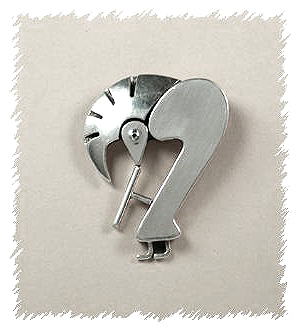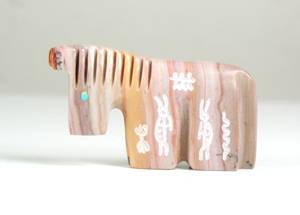
Kachinas, supernatural spirit beings, are called “katsina” by the Hopi and “Koko” by the Zuni (which means “raw people”). Kachinas are associated with rain and other good things such as longevity, strength and good fortune. Kachinas serve as an intermediary between the people and the gods to bring blessings to the entire universe.
Today depicted as a non-gender figure, kokopelli was traditionally a male figure, often well endowed until the missionaries discouraged such depiction ! Tales include the kokopelli visiting and by morning, all of the young women were pregnant.

Here is an excerpt from North American Indian Jewelry and Adornment by Lois Dubin

The kokopelli might be simple or have various adornments. It most always is holding and playing a flute, which announces his arrival and is suggested to represent rain, precious to the southwest. His legs are dancing in time to his own music. Sometimes kokopelli is depicted with feathers or a headdress protruding on the top of his head. In a few instances (mostly rock art) he has been depicted with a stick or bow. He is most always shown in profile.

Milton Howard, Hopi
Kokopelli talks to the wind and the sky. His flute can be heard in the spring breeze, bringing warmth after the winter cold. He is the symbolic seed bringer and water sprinkler. His religious or supernatural power for fertility is meant to invoke rain as well as impregnate women both physically and mentally. He is also associated with fertility of wild animals.
From a Field Guide to Rock Art Symbols of the Greater Southwest by Alex Patterson
The humpbacked kokopelli image is found from Casa Grande, Mexico to the Hopi and Rio Grande Pueblos and then westward to the Californian deserts in prehistoric rock, effigy figures, pottery, and on kiva walls. Some say the reason he has a hump or is bent over is that he was carrying a heavy sack, perhaps full of seeds or some say with an unborn child he is going to deliver.
Anasazi, Hohokam and Mibres peoples used the symbol on their pottery. Today many southwest Native Americans use the symbol on their pottery.
Many Native American tribes use the kokopelli symbol. Here are some samples of its usage by Hopi, Zuni, Navajo and Oglala Lakota artists. Click the photos for more information.

You may have heard of Ledger Art, where Plains Indians used the materials at hand, such as old ledger paper from forts and missions, on which to paint and draw. Well, this is Cigar Box Art, a creative repurposing of vintage cigar boxes by Lakota artist Alan Monroe.This box has a large capacity so will hold quite a few treasures or a good amount of sage and other smudging supplies.
This article is meant to round up the various interpretations of kokopelli, not serve as a definitive tome on the subject.
Paula










Pingback: Native American Symbols – Kokopelli | Native American Jewelry Tips
Always love reading your articles. Thanks for doing this. Joy
And I appreciate your comment ! Thank you Paula
Always love reading your articles. Thanks for doing education is the best way to keep tradition . Joy
That’s a clever phrase and so true ! My pleasure. Paula
I am interested in buying a nice quality Hopi Kopkopelli kachina doll and a nice quality Hopi Left Handed kachina doll.
Thank you.